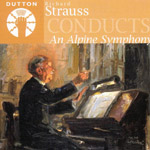Some composer-conducted recordings, such as those by Stravinsky or Britten, can reveal unique aspects of both a work and its composer. However, the only thing this performance of the Alpine Symphony reveals is that Richard Strauss seems to have not liked his own music very much. It would be difficult to imagine a more faceless, uninflected, and drab rendition of this usually grandiloquent work. Strauss pretty much acts as metronome, setting a basic tempo and budging nary an inch from it. The Bavarian Staatskapelle responds with a commensurate level of indifference, and in some instances incompetence. Entrances are missed (most egregiously the timpani in On the Glacier), cracked trumpet notes (everywhere), and tuning so bad it should be called “outonation”. Add to this the dynamically limited 1941 recording’s inability to suggest the scale of a foothill, much less a mountain, and you’ve got what amounts to a freeze-dried, vacuum-packed Alpine excursion. You’re far better off hiring Ashkenazy, Previn, or Järvi as your guide–any one of them will certainly give you a fuller and more bracing high-altitude experience.
From the same year comes a brief selection of waltzes from Der Rosenkavalier’s third act, which finds both conductor and ensemble (the Bavarian Staatsorchester) considerably more involved and animated. But with Don Juan we’re back to Strauss on cruise control (even though he was 12 years younger at the time), and the Berlin State Opera Orchestra on skids as it scrambles to keep up with the composer’s breathless tempo. Look, if you want to hear Don Juan taken this fast (with all the notes where they’re supposed to be), go for Reiner, Kempe, and especially Szell, who also conducted an early recording under the composer’s supervision. The sound in this case is noticeably dimmer and more opaque than the later tapings.
































